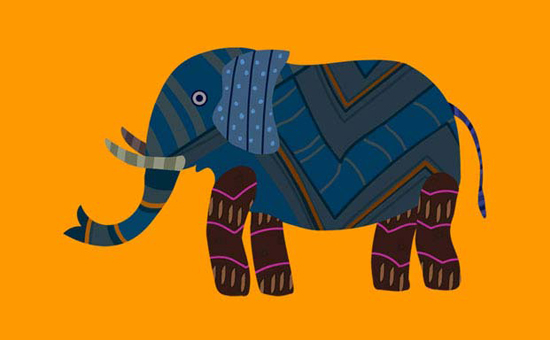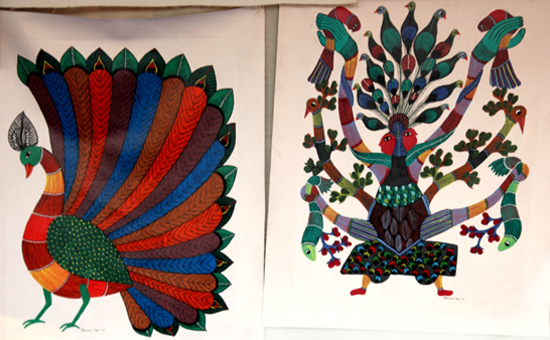- This article is a brief introduction to Gond Art, its origins - painting process and prominent colours.
Gond
is a form of Indian folk and tribal art named after the largest tribe of
central India with the same name. The word Gond is a derivation of the konda
word meaning green hill which consists of parts of Madhya Pradesh,
Chhattisgarh, Andhra Pradesh, Maharashtra, and Orissa.
The
word Gond comes from the Dravidian expression kond, meaning green mountain .The
Gonds were the ruling class in many parts of Central India in the 14th century.
Gond rajas, or kings, ruled until they were conquered by Muslim armies and were
forced to flee into the thick jungles.
In
the Gond belief system, besides Bara Deo (Great God), every hill, river, lake,
tree, and rock is inhabited by a spirit and therefore sacred. Like most
tribals, the Gonds are artistically gifted: they paint their house walls with
artistic designs. Both male and female family members participate in painting.
Gond paintings are done on village mud walls using colors derived from charcoal, colored soil, plant sap, leaves, and cow dung and can last up to 20 years. These paintings are found in the inner and outer walls of the houses, windows and niches. Gond paintings reflect man’s relationship with Nature.
In
Gond art, horses, stags, tigers, birds, gods and people are painted in several
bright colours and filled with dots, lines or other geometrical patterns to
give it a texture. This style of painting has been called by various names:
Jangarh Kalam, Pardhaan painting, Gond painting, etc.
Painting Process
Gond
paintings are fascinating, where the artists express their faiths and beliefs,
world view, their visual expression and sense of identity, both as a
collective, and as individuals. Gond paintings are based basically on line
work. The artists draw the inner and outer lines with utmost care that are so
striking in their precision and perfection. The imaginative use of the line
imparts a sense of movement of still images. The colours are mainly black and
white, red, blue and yellow.
The
motifs are further associated with the rich repertoire of the community and
strongly show the interactions with the cosmic, natural and social worlds of
humans at multiple levels and contexts. Local deities, cock fights, forest
scenes, agriculture, marriages and other rituals find a place in these
paintings. Gond artists paint their lives vividly, drawing from their heritage
which gives them a rich canvas.
The
inspiration behind Gond art is almost always nature and social customs
represented through a repetitive patterning of dots and dashes. Each artist
uses this patterning to create his or her own signature style while choosing
colour schemes and subjects that are indicative of the communities they
represent.
 Gond Painting.
Gond Painting.
Prominent colours
Deep
red - derived from Al tree, Yellow - from Chui mitti (Local Sand), Brown - from
Gheru mitti (Another type of Sand), Green - from leaves, and Red - from
hibiscus flower
Originally,
natural colours were used for painting. Nowadays because of non-availability of
natural colours and the easy availability of alternative colours, the artists
have begun to utilize poster colours in their work. Black and white colours
were not generally used, but now they are also being used.
The
Gonds traditionally painted on mud walls of their houses. Starting in the
early 1980s, certain talented Pardhan Gonds who traditionally serve as
professional bardic priests began transforming their ritual performing arts
into a new tradition of figurative and narrative visual art: using a variety of
modern media (including acrylic paintings on canvas, ink drawings on paper,
silkscreen prints, and animated film) they have created unprecedented
depictions of their natural and mythological worlds, traditional songs and oral
histories. Rich in detail, colour, mystery and humour, these tribal
artworks brilliantly employ modern means to evoke the
pre-modern psyche.
The Gond art rendezvous with the belief that "viewing a good image begets good luck". This inherent belief led the Gonds to decorating their houses and the floors with traditional tattoos and motifs. The Gond paintings also bear a resemblance to Australian aboriginal art.
Author Trishna Patnaik is a Fine Artist based in Mumbai.
To read all
articles by author
 Gond Painting.
Gond Painting.

To read all articles
on Indian Art
Also
read
1.
Pichwai
Art
2.
Warli
Paintings
3.
Bastar
Craft and Culture
4.
The
Paintings of India